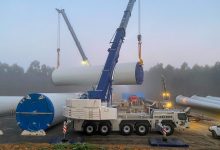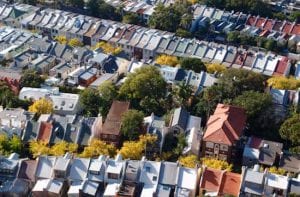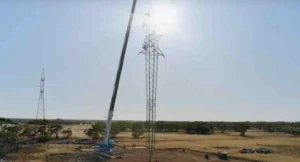I’d like to be talking about the positive aspects of Australia’s decarbonisation plans, and the policy choices between US-style tax incentives that lower electricity prices at the expense of budget deficits, and Australia’s certificate system, which raises electricity prices and but which does keep the government budget “pure.”
There is a lot to write about. But the grim reality is that there is little point discussing the fine points of policy when the main players that interface between those policies and customers – the electricity gentailers who generate electricity and sell power to consumers – have done so little.
What a disappointment they have been. How they let the side down. How little their boards seem to care about future generations.
AGL, Origin Energy and EnergyAustralia have the majority of electricity and gas retail and wholesale customer market share in Ausstralia. This gives them a moral responsibility to take the lead in decarbonising Australia.
Decarbonisation is a well recognised scientific necessity. Australia has a good record, for instance, about limiting tobacco.
But utility management and boards behave like small-minded, narrowly focused, quarterly earnings-driven people; more concerned with the annual performance bonus than taking the lead or even keeping up with the pack.
As a result they hold Australia back and act as a hidden but extremely large barrier to policy implementation and desire of government and consumers.
Rarely has this been as clear as when reading such disingenuous or perhaps simply tone deaf AFR quotes attributed to AGL CEO along the lines of “AGL is going as fast as it can.”
I virtually fell off my chair laughing. In fact, it still makes me smile, and squirm.
And then I thought how embarrassing it must be for the AGL board to read such complete guff from their new CEO. And then I thought, well, actually AGL’s basically “new” board had already embarrassed itself endorsing AGL management plans. And then I thought, the board is so junior perhaps they can’t be blamed.
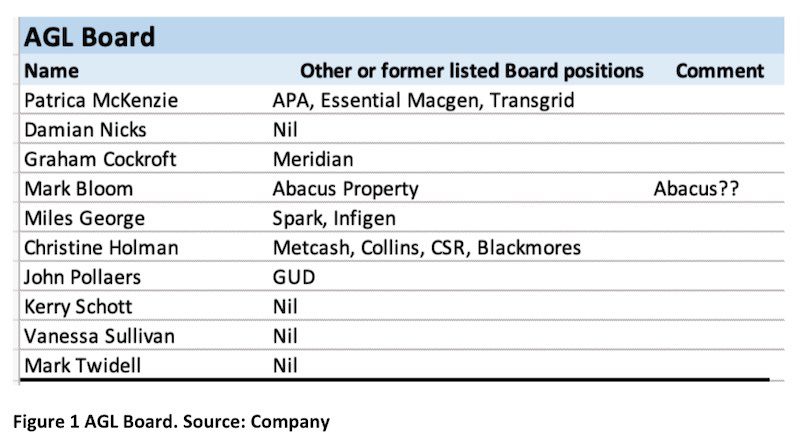
Only two of the board members were appointed prior to 2022 and the chair only became a director in 2019. So it’s an inexperienced board in terms of ASX 100 public company board experience, and inexperienced in AGL culture.
In this particular case, AGL is coming off one of its periodic changes of strategy (it has more changes of strategy than any other public company I’ve ever followed) and no doubt directors want to be there for a long time, rather than a good time and don’t want to rock the boat.
Even so, CEO Damien Nicks’ comments that AGL is “going as fast as we can” as quoted in the AFR strikes a very raw nerve in that it only reflects the f*** you approach the large gentailers have had for years.
Perhaps, as AGL said at its investor day, it does take a long time to develop renewable options. Seemingly forever, in fact. Makes waiting for Godot seem quick. The question is why AGL doesn’t have those options ready to go.
Equally, even if AGL succeeds in procuring its 6GW of wind and solar by 2035, when I likely won’t be here to see it; even if it does eventually procure that 6GW, that still won’t replace anything more than 60% of its current coal generation.
How can the Board accept such a lack of ambition? How can investors invest in a company with so little ambition? One imagines two fundies lunching at Aalia:
FUNDIE 1: Oh I own AGL, it’s going to do something one day and it’s doing ok from coal generation.
FUNDIE 2: Should I sell my lithium shares then?
F1: Yeah sure. Mind you, it doesn’t have a plan to get its customers off gas, but it will be ready when they do.
F2: Cool bananas! Is that like Tesla or Nextera or CSL or Carsales?
Anyhow, I digress.
Gentailer decarbonisation efforts are a disgrace
The gentailers have decarbonsiation targets, they offer carbon-free retail plans, they run VPPs and try to make money from EVs. They are happy enough to build batteries. In fact, each of them is proudly building batteries. But all of these things are peripheral.
The following table is the list of new wind and solar PPA/developments agreed to by AGL, Energy Australia and Origin since Jan 1, 2020. That was as far back as I could be bothered to search. One small project between them in 3.5 calendar years. One small PPA of a half-built wind farm. FFS.
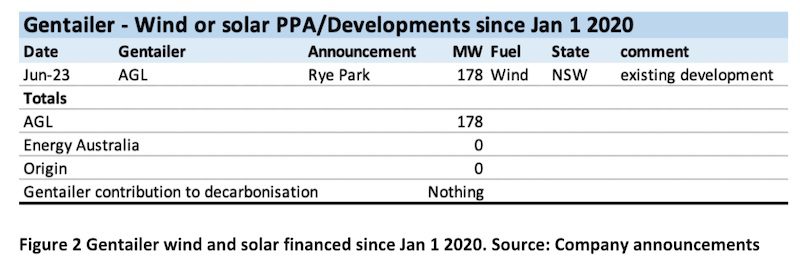
What hope is there of replacing the 30% of demand supplied by gen-tailer coal generation if the gen-tailers, the most fit entities to do the job, don’t build or cause to be built any new supply?

If I’ve missed anything, happy to correct the table. Brookfield has announced a 400MW windfarm and battery in Central Queensland, for instance.
Indeed, I have hopes that Brookfield might actually make a difference, if they get control. But then I had hopes that Grok’s investment in AGL might lead to something, when clearly it hasn’t.
It’s true that AGL was part of the PARF consortium that purchased Tilt, but if anything all that has done is slow Tilt down.
Origin announces a big fat symbolic donut to replace Eraring
A donut is appropriate because that seems to be what the Origin logo is based on (no doubt the logo reflects a subconcious expression).
Origin Energy has done nothing in wind or solar, although its erstwhile suitor Brookfield talks a good game. Origin has invested in Octopus. Octopus’s value has wildly increased because they offer consumers what they want.
More to the point, Origin announced the likely closure of Eraring in 2022 but has announced a total of zero about how its going to replace Eraring’s supplied energy. That’s a prime example of social license violation in my opinion. Pretty much equivalent to a soldier deserting the battlefield.
I am as capitalist as the next person, but as an analyst it’s very hard to support a business which has such a backward view on its future.
I guess it’s particularly disappointing because, via Octopus, Origin management has shown it does have an eye for the future and the willingness to take a chance. Just not when it comes to building new supply in Australia.
Batteries and coal-gen maintenance, that’s all that’s needed
Looking at the capex plans and the PPA announcements of EnergyAustralia, AGL and Origin one might imagine that all we need to do to decarbonise Australian electricity generation is build some batteries.
I’m as big a fan of batteries as the next analyst, in fact I’d argue I was talking about household batteries at an IPART conference where I seem to recall I was sitting next to Frank Calabria, a couple of years before Tesla was even making them.
But you can’t run a battery without charging it and charging a battery from patched together and ancient coal kit is hardly a business plan I can invest in.
Batteries are net consumers of energy. AGL adding up its batteries and wind and solar to make 12GW when in fact its actually doing 6GW of replacement supply and a further 6GW to shift around when the first 6GW is available to the market is, in that sense, adding apples and oranges and telling stakeholders the result is bananas.
Shareholders agree, the result is bananas.
Coal generation capex preferred to wind and solar
EnergyAustralia and AGL have both announced they will spend more capex on their coal generation assets. In AGL’s case to the tune of $400-$500 million a year.
EnergyAustralia
The road to hell may be paved with good intentions, but at least in EnergyAustralia’s case they don’t make false claims. They recognise decarbonisation is happening and then get right on with expanding their gas plant and maintaining the coal generation business, and building batteries.
Historically, Energy Australia (EA) has interests in 615MW of wind in Australia (all of which was built years ago) and 300MW of solar.
However, I think the most recent project for EA to contract with was Coleambally Solar (commissioned back in 2018). As far as I know, EA does not have any plans to develop wind or solar assets in Australia.
But then what else would you expect from a subsidiary of one of the slowest moving utilities globally, that is CLP. CLP will decarbonise, one day, some day, if they have to. No doubt they’ll get there by 2050.
And this likely explains why CLP is having so much trouble finding a partner to buy part of its EA stake. Every asset has a price and at some price someone will surely take EA on, but really why would you want to partner with CLP?
Beyond an over-the-water and out of reach, never to be touched balance sheet, what does CLP offer? Does it have a plan or a vision likely to attract investors? A willingness to help build the future, to be part of indeed lead Australia and Asia through this major energy transition? Does CLP even recognise its role as the primary interface between policy and consumers?
The answer is obviously no. The fact is that lack of ambition kills big companies as surely as over-ambition does.
My personal view is that CLP either needs to commit to Australia and decarbonisation or bite the bullet and abandon the field.
To me, CLP stands as a firm roadblock to EA making something of itself. And yet even if EA was 100% listed company there would be a question of whether it would do anything different. After all AGL is no better and nor is Origin.
AGL is “going as fast as it can” – my ass
AGL according to its CEO is “going as fast as it can.” A good indication of its decarbonisation pace can be seen from its capex history and near term forecast.
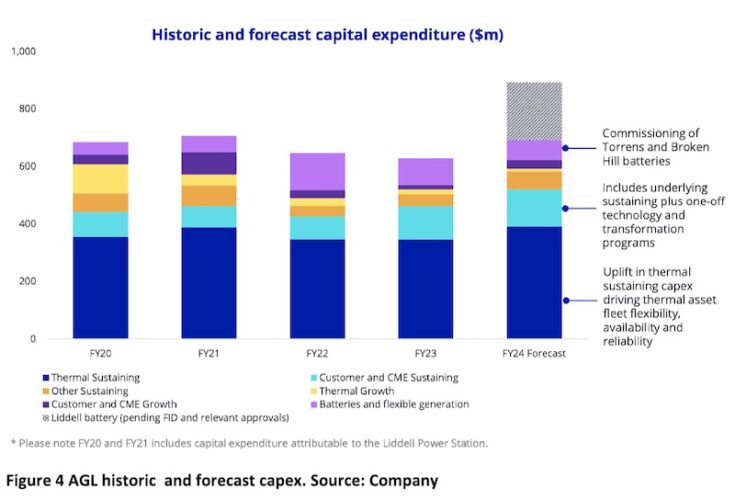
AGL will spend more and not less on its thermal fleet, going forward it’s about $400-$500 million a year to keep the coal-gen plants running.
But more generally, there is nothing in the near term capital expenditure for new wind and solar, all there is is batteries. In this regard it’s the same as Origin and EA. Anything but wind and solar.
To be fair, the wind and solar spending, such as it is, takes place after 2026 as disclosed at its investor day briefing.
AGL’s investor day plans
AGL announced plans to add 6.3GW of wind and solar largely through offtakes and partnerships by the end of 2035.
Leaving aside that 2035 is almost the new 2050, by which I mean it’s management speak for “doing nothing now,” the fact is that 6GW of wind and solar translates to about 17TWh which is only 60% of the 28TWh they currently produce from coal generation.
That is, they plan to give up 40% of their current coal market share. That is at least better than Origin and EA which, on current plans, are going to give up 100% of their coal market share.
As the following figure from AGL’s investor day makes clear, the share of earnings from renewables and offtakes is not expected to change. Instead AGL expects to make its money in the future from firming and to a lesser, but still growing extent from customer markets.
In fact, AGL made it clear that it didn’t expect to do anything in regard to wind or solar prior to 2026.
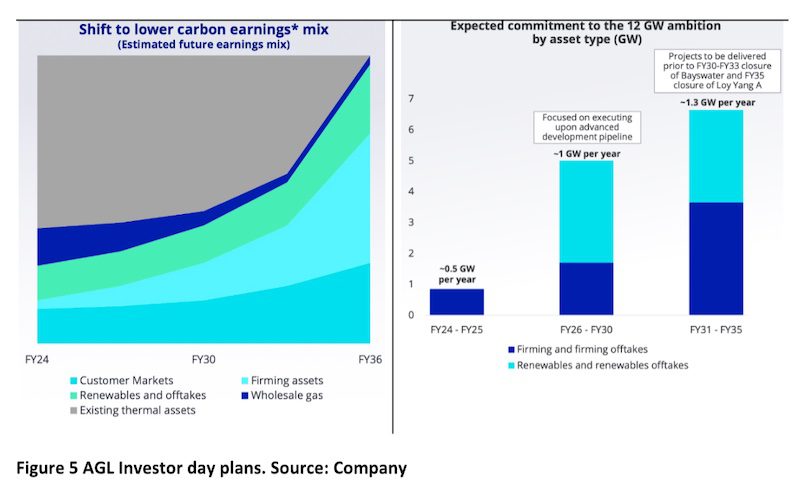
AGL says that a ”projected shift to electrification is expected to result in a gradual decline of gas demand.” But does it plan to encourage its customers to shift? I doubt it.
The reason is, of course, the earnings from the gas customers and the gas contracts. To be fair, AGL is setting up a centre for household electrification that will develop ways to retain customers that shift from gas.
But I find it hard to see management incentivising customers to shift. At least not before its current wholesale gas contracts expire.
Conceptually, though, if AGL had the appropriate ambition it could shift faster. It could encourage customers to electrify (onto AGL’s coal fuelled supply) and sell off the gas contracts.
Sigh. What a depressing note to have to end on.

